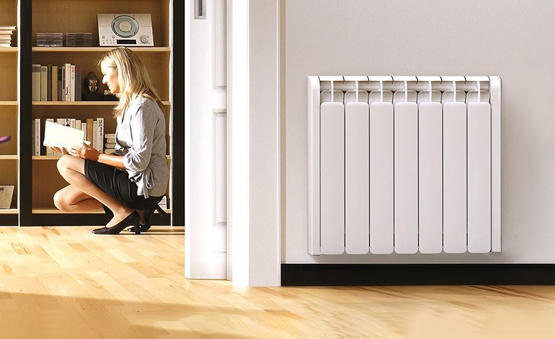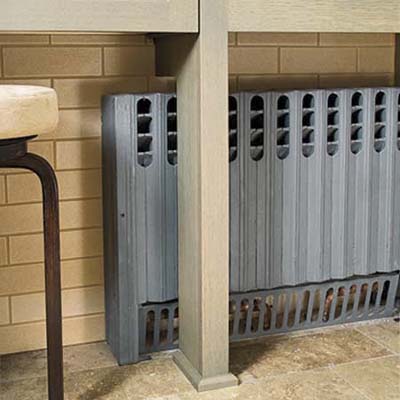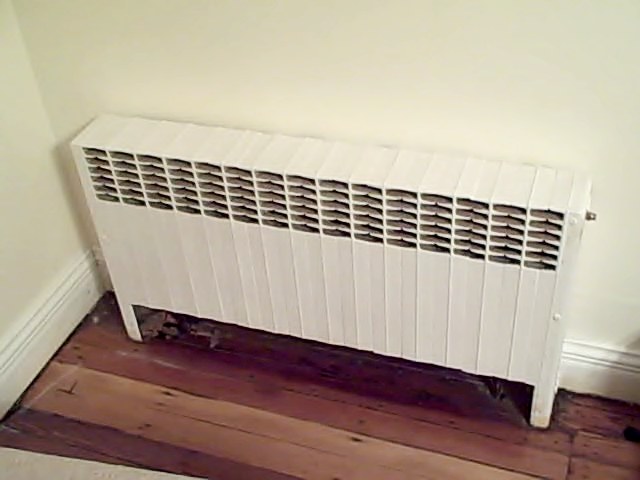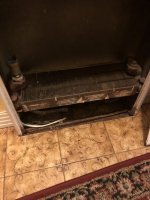You are using an out of date browser. It may not display this or other websites correctly.
You should upgrade or use an alternative browser.
You should upgrade or use an alternative browser.
Convector element. What type of radiator is it?
- Thread starter Bnisimov
- Start date
Users who are viewing this thread
Total: 2 (members: 0, guests: 2)
Sponsor
Paid Advertisement
Hi
Im thinking of updating my radiators. My heating system is water boiler (not steam).
Can you identify what type of radiator in the picture?
What type of radiator would you recommend for maximum heat and efficiency?
Thank you
It's not a radiator- it's a fin tube convector.
To figure out it's output specs, measure the cabinet height width and depth dimensions, as well as those of the fins, and find a current product that is similar. Modine is likely to still be selling something that is close enough. As long as they specify it at some average water temperature or entering water temperature it's possible to infer what it would deliver at your normal water temp, and compare it to other radiator types. Since yours doesn't appear to be built into the wall you have some flexibility in width/height/depth for what replaces it.
By "...maximum heat..." are you implying that the rooms aren't warm or comfortable enough? If the room to room temperature balance is reasonable replacing each convector with something of equal output at a given temperature is fine, but make note of any rooms that are often too cool or too warm, in which case some adjustments to the radiation sizing can be made.
Go ahead and find an appropriate series of convectors to compare, and add up the total amount of radiation on each separately controlled zone. Then run a fuel use based heat load calculation. With that data it's possible to come up with the approximate water temperatures needed (lower water temperature=more comfortable, more efficient).
With the calculated load number and the nameplate output BTUs on the boiler the approximate oversize factor on the actual heat load can be inferred, and the water temperature at which the radiator output balances with the boiler output can be estimated.
The oversize factor relative to the heat load and or the radiation affects how the system as a whole needs to be controlled for maximum efficiency.
If it looks like there is enough radiator/convector output to cover the design heat load at 140F or lower it's worth considering replacing a older fully functional but way oversized boiler with a right sized modulating condensing boiler then dialing-in the outdoor reset temperature curve to max out both comfort & efficiency.
European style convecting panel radiators are usually quite a bit more comfortable than fin tube convectors, but Eastern European/Asian style bimetal convecting rads aren't bad either. There are plusses and minuses to either/both, but the most important thing is sizing it correctly (and proportionally room by room ) for the loads.

^^bi-metal convecting radiator^^

^^panel radiator^^
On 1950s or earlier houses it's sometimes nice to stick with period-appropriate 5" deep x 20" tall cast iron convecting radiors such as Arco Sunrad or Burnham Radiant, etc., which are often available on the used market for dirt cheap. (But watch out- they're pretty hefty- you may need to hire your big sister to help move 'em.)

^^Burnham Radiant type^^

^^Arco Sunrad type^^
"By "...maximum heat..." are you implying that the rooms aren't warm or comfortable enough? If the room to room temperature balance is reasonable replacing each convector with something of equal output at a given temperature is fine, but make note of any rooms that are often too cool or too warm, in which case some adjustments to the radiation sizing can be made."
I think they would be better off using the element sized for the space rather than downsizing because why heat rooms they are not in and as the sun changes positions rooms become hotter or cooler
How about Cast Iron elements that hold the heat longer and use non electric radiator zone valves with a remote bulb?
http://governaleindustries.com/products/convectors/ <<< one of my favorite manufactures
Danfoss 013G8252 Non-Electric Zone Valve Operator - Danfoss Operator W/Remote 6' Cap -
My house has 10 rooms over 9 with a 14 foot ceiling in the basement and 9'- 4" ceilings throughout the house
All my radiators are freestanding cast iron except in the living room which is cast iron baseboard and in the hallway as we enter the main floor
The bathrooms have cast iron elements inside the cabinet built in the walls and have non electric zone valves (various brands) as I wanted to test them before installing them for my accounts
I like either Danfloss or Brockman as both have been in service from the late 1970's
This has allowed me to play games without the need for indoor / outdoor temperature increase etc
Once the system is balanced then it usually does not need any more tampering
Cast iron not only holds the heat for a long time it is quiet and lasts literally for over a century
I think they would be better off using the element sized for the space rather than downsizing because why heat rooms they are not in and as the sun changes positions rooms become hotter or cooler
How about Cast Iron elements that hold the heat longer and use non electric radiator zone valves with a remote bulb?
http://governaleindustries.com/products/convectors/ <<< one of my favorite manufactures
Danfoss 013G8252 Non-Electric Zone Valve Operator - Danfoss Operator W/Remote 6' Cap -
My house has 10 rooms over 9 with a 14 foot ceiling in the basement and 9'- 4" ceilings throughout the house
All my radiators are freestanding cast iron except in the living room which is cast iron baseboard and in the hallway as we enter the main floor
The bathrooms have cast iron elements inside the cabinet built in the walls and have non electric zone valves (various brands) as I wanted to test them before installing them for my accounts
I like either Danfloss or Brockman as both have been in service from the late 1970's
This has allowed me to play games without the need for indoor / outdoor temperature increase etc
Once the system is balanced then it usually does not need any more tampering
Cast iron not only holds the heat for a long time it is quiet and lasts literally for over a century
Attachments
"Cast iron not only holds the heat for a long time..."
How long the heating element "...holds the heat..." is primarily a function of it's thermal mass, which is largely about it's water volume. A gallon of water has the same thermal mass as 76 lbs of cast iron. This is one of the aspect in favor of panel radiators compared to bi-metal convecting radiators or fin-tube convectors- the panel rads have a lot more volume. Cast iron radiators almost always have more thermal mass in their water volume than in the cast iron. The short sheet spec on Governale's cast iron elements doesn't specify either the volume or the dry weight, which makes it hard to compare apples-to-apples from "...holds the heat..." thermal mass aspect when designing a system, but it has to be substantially more than fin-tube.
In a decently balanced modulating system operating under outdoor reset control the thermal mass becomes less of an issue, since the radiators are always "on" and don't need to "hold the heat" between cycles.
Governale's "Gov-Ray" or OCS's "Cast Ray" is equivalent in almost all respects (including appearance) to the Burnham Radiant, which equivalent in thermal mass to Sunrads and other vendors' product of equal height & depth. A used Sunrad/Radiant or similar is still quite a bit cheaper than a new Gov-Ray or Cast Ray and they really DO last pretty much forever.
Cast iron baseboard is another way to get real radiation with some amount of thermal mass into the room without giving up much floor area.
But whether any cast iron options qualifies as "...updating my radiators..." is up to Bnisimov. Panel rads and bi-metal convecting radiators arguably impart a more "updated" look, compared to refitting the existing sheet metal of a 1950s fin tube convector with a cast iron element, which is invisible.
How long the heating element "...holds the heat..." is primarily a function of it's thermal mass, which is largely about it's water volume. A gallon of water has the same thermal mass as 76 lbs of cast iron. This is one of the aspect in favor of panel radiators compared to bi-metal convecting radiators or fin-tube convectors- the panel rads have a lot more volume. Cast iron radiators almost always have more thermal mass in their water volume than in the cast iron. The short sheet spec on Governale's cast iron elements doesn't specify either the volume or the dry weight, which makes it hard to compare apples-to-apples from "...holds the heat..." thermal mass aspect when designing a system, but it has to be substantially more than fin-tube.
In a decently balanced modulating system operating under outdoor reset control the thermal mass becomes less of an issue, since the radiators are always "on" and don't need to "hold the heat" between cycles.
Governale's "Gov-Ray" or OCS's "Cast Ray" is equivalent in almost all respects (including appearance) to the Burnham Radiant, which equivalent in thermal mass to Sunrads and other vendors' product of equal height & depth. A used Sunrad/Radiant or similar is still quite a bit cheaper than a new Gov-Ray or Cast Ray and they really DO last pretty much forever.
Cast iron baseboard is another way to get real radiation with some amount of thermal mass into the room without giving up much floor area.
But whether any cast iron options qualifies as "...updating my radiators..." is up to Bnisimov. Panel rads and bi-metal convecting radiators arguably impart a more "updated" look, compared to refitting the existing sheet metal of a 1950s fin tube convector with a cast iron element, which is invisible.
I rather have a lower heating bill and much more comfort and longevity so I stick with cast iron. Copper is ok but gives up the heat to fast and I hate the squeaky sounds
I used to buy CI free standing sed radiator $10.00 a section and have them sand blasted especially the embossed ones as they then can be sold for $100 per section
I used to buy CI free standing sed radiator $10.00 a section and have them sand blasted especially the embossed ones as they then can be sold for $100 per section
Cast iron radiation isn't going to lower the heating bill, but it will improve the comfort over copper fin-tube convectors. It's no more comfortable than panel rads though. Re-using cast iron is one way to keep it affordable.
Squeaky-creaky (and ubiquitous) fin tube baseboard is the most annoying but cheap. I wouldn't want to install it in my house, but I understand why it became the low-budget standard for tract housing.
My 1920s house has a combination of Sunrads & cast iron baseboard (all cleaned-up reclaimed goods) one radiant floor zone and one hydro-air zone. The hydro-air is oversized (I didn't install it, or the radiant), and annoying enough that I use the wood stove in that zone most of the time. The wood stove is a lot more comfortable and quieter than the hydro-air, but requires more user-interaction.
Squeaky-creaky (and ubiquitous) fin tube baseboard is the most annoying but cheap. I wouldn't want to install it in my house, but I understand why it became the low-budget standard for tract housing.
My 1920s house has a combination of Sunrads & cast iron baseboard (all cleaned-up reclaimed goods) one radiant floor zone and one hydro-air zone. The hydro-air is oversized (I didn't install it, or the radiant), and annoying enough that I use the wood stove in that zone most of the time. The wood stove is a lot more comfortable and quieter than the hydro-air, but requires more user-interaction.
My house also 1920's original boiler was HB Smith 13 section CI coal fired replaced with with oil during the 1950's and in the 1980's I installed two boiler gas fired boilers existing piping .existing rads and non electric zone valves. Because CI holds the heat it saves from over firing to maintain delta of 15 DEG
My house also 1920's original boiler was HB Smith 13 section CI coal fired replaced with with oil during the 1950's and in the 1980's I installed two boiler gas fired boilers existing piping .existing rads and non electric zone valves. Because CI holds the heat it saves from over firing to maintain delta of 15 DEG
In your system it's likely that most of the thermal mass is in the distribution plumbing and possibly the boiler volume, not the cast iron, and certainly not the cast iron mass of the radiators. The thermal mass of cast iron is about 0.11 BTU / lb per degree F. The thermal mass of water is about 1 BTU /lb per degree F.
Even in most cast iron radiators most of the thermal mass is in the water. A thin walled steel radiator (not a bimetal convecting radiator) that has real volume can have as much or more water mass than a cast iron radiator.
Taking as an random example a Burnham CR-5-CF , (listed on p.3) which has a dry weight of 129 lbs, and has five sections of 0.61 gallons each (read the fine print.) The water mass is 8.34lbs/gallon x 0.61 gallons/section x 5 sections= 25.4lbs of water.
The water-equivalent mass of 129lbs of cast iron is 0.11 x 129= 14.2 lbs
So even in the radiator the water volume is nearly 2/3 of the total thermal mass, even though the cast iron weighs ~5x as much the water. It's the water far more than the cast iron that is "...holding the heat...".
Similar threads
- Replies
- 7
- Views
- 320
- Replies
- 7
- Views
- 254
- Replies
- 7
- Views
- 434


